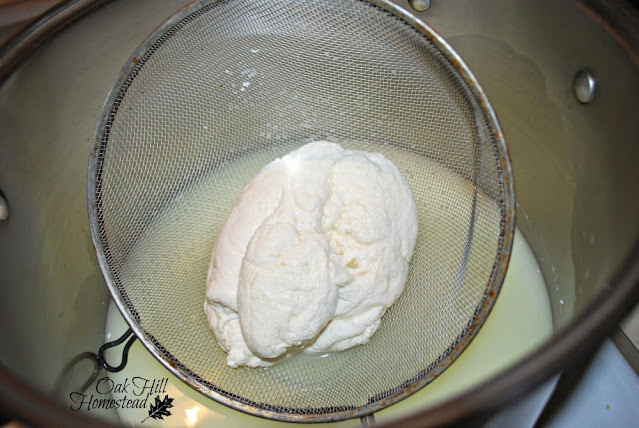How to make mozzarella cheese from scratch
Several years ago, in celebration of National Goat Cheese Month, I challenged myself to make a different kind of cheese every week.
My Nubian goats - Felicity, Ziva, Firefly, and Phoenix - provided the milk I used in my cheese making attempts.
You don't have to use goat milk, but if you're buying milk from the grocery store I recommend buying whole milk. Skim and low fat milk don't work as well for cheese making.
My past failures at making mozzarella
I had tried to make mozzarella a couple of times without success but I promised myself I was going to be successful this time. In fact, mozzarella was the whole reason I gave myself this challenge. I would conquer this skill.
I would!
So, I must admit that I approached mozzarella cheese with a lot of trepidation since I had failed utterly (udderly?) twice in the past.
So I started early in the week in case I had to try more than once.
Sure enough, I did have to make it twice, but this time the reason was that my camera battery died halfway through the first batch. Great timing.
You can't stop in the middle of cheese making because the camera battery died.
But you know, that wasn't a bad thing. I learned from each batch that failed, including this third batch that technically wasn't a fail but wasn't a great success either.
When I read through the directions again after that third batch, I realized where I'd made mistakes. I let the cheese get too hot at one point and the curds were much firmer than they should have been.
But I did get to practice stretching the curds, even though they were far from perfect, and I "got it" eventually.
I consider this a complicated cheese. It isn't that hard but there are so many steps to remember that it seems difficult.
The ingredients you'll need to make mozzarella cheese
Here's what you'll need:
- a gallon of milk - store bought or from your own goat or cow
- citric acid
- rennet, either liquid or tablet
- cheese salt
- Or you can buy Hoegger Supply's "mozzarella kit" which contains these last 3 ingredients. All you add is the milk! This is what I did.
The equipment you'll need
Gather the equipment you'll need before beginning. Like I said, mozzarella is complicated and you don't want to be distracted by trying to find a slotted spoon.
- stainless steel pot that holds at least 5 quarts
- slotted spoon
- thermometer
- strainer
- a pan the strainer will fit inside
- a long knife or spatula that reaches to the bottom of the pot
- bowl of cold water
- rubber gloves to insulate your hands from the hot curds
The directions
To start, dissolve 1 1/2 teaspoons of citric acid in one cup of cool water in a bowl.
I used filtered water rather than tap water. We have "rural water" which is really city water, and over the years I've found that filtered water works better in everything I do.
In a second bowl, measure another 1/4 cup of cool water and add 1/4 teaspoon of liquid rennet. If you don't have liquid rennet, use a quarter of a tablet of rennet.
Here's a tip - none of the recipes that I've read have mentioned this, but I will continue doing it in the future - put a pot of water on the stove and begin heating it up. You want it to be about 190°F; but don't let it boil.
Do this now. We'll use it later on.
Now pour the gallon of cold milk into a large stockpot that will hold at least 5 quarts.
Add the citric acid that's mixed with water.
Set the pot of milk on medium high heat and warm it slowly to 90°F, stirring gently.
When the milk reaches 90°F move the pot off the heat and stir in the water and rennet. Stir gently for 30 seconds (I counted to 30), then cover the pot and let it sit undisturbed for five minutes.
The directions I was following said if it isn't set enough after five minutes - if the curds look too watery - put the cover back on the pot and leave it for another five minutes.
Mine looked fine, like custard, so I continued.
The curds should look like a layer of tofu or custard.
Cut this layer into similar-sized cubes with a long knife or spatula. Cut in one direction, then across in the other direction, making sure the knife reaches all the way to the bottom of the pot.
This was kind of difficult because the mass of curds kept spinning around the pot while I was trying to cut, but eventually I managed to cut it all into cubes.
Then put the pot back on the stove over medium heat and heat it up to 105°F. This doesn't take long at all, so don't let your attention wander.
This is where I overcooked my first batch!
Stir gently as it warms but don't break up the curds too much.
Directions like this are hard for me. Where is the line between enough and too much?
Remove the pot from the heat again, and continue to stir for another five minutes. The cubes of curds will begin to stick together and form a big clump, making a mass of curds in the liquid whey.
Mine kind of looked like a lump of marshmallow cream.
Ladle the curds out of the whey into the wire strainer with a slotted spoon. Turn the curds over a few times in the strainer to let the whey drain out of the little nooks and crannies.
Save some of the whey! You'll need it later for storing your cheese.
Plus you can feed the whey to your dog, cat or chickens - or use it in lacto-fermented dishes - or to replace the liquid in bread recipes.
This is when you'll need that pot of water that I suggested you put on the stove at the beginning. It's handy to have it ready when it's needed, and not have to wait for the water to get hot while worrying about the curds getting too cold.
Set the strainer of curds in the pot of water so that the curds are submerged, and let them warm up in the water for five minutes. Stick the thermometer inside the curds; the interior should be 135°F.
Stretching the curds
Don your rubber gloves and add the cheese salt, squishing it in well with your fingers.
The curds, which used to be one solid mass that was rather stiff, should now be melty and squishy after warming up in the water.
Using a big spoon, pull off a chunk of curds from the big mass in the strainer. I made four balls of cheese in all, and left three in the warm water while I worked with the first one.
Use your hands to stretch the curds. It's kind of like kneading bread dough, although it's done in your hands rather than on a flat surface. I stretched the ball of dough apart, folded it under, rotated it slightly, stretched it again.
Don't overwork the cheese. Fold it into a ball and smooth the surface, then plop it into a bowl of cold water, and start on the next hunk of curds.
I know now that the first batch I made wasn't hot enough to stretch properly. This batch was a joy in comparison. Having that pot of warm water ready to use when you get to this point was a genius idea!
Keep an eye on the water temperature while you're stretching the curds, and don't let it start to boil. I needed to turn off the heat under the pot after stretching the first two balls of cheese.
Eating and storing your fresh mozzarella cheese
Mozzarella is ready to eat immediately, no draining, aging or curing required.
If you want to store your mozzarella in the refrigerator, mix a teaspoon of salt with a cup of the cool whey (the liquid that was left when you removed the curds from the pot).
Pour this salt and whey mixture over the cheese in a small container so it's covered with liquid. Your mozzarella should keep in the refrigerator for about a week.
A few tips
Honestly, I'm glad I had to make two batches. The first batch taught me a lot. The second batch was so much easier and turned out to be perfect!
And I learned a few tricks, like getting that pot of water heated up before I needed it. When I began stretching the second batch, the difference was amazing and I could tell that it was "right" because I'd already struggled with that first batch that was "wrong."
I'm looking forward to making my homemade pizza with homemade mozzarella on top, and to making calzones. Homemade cheese is so good!
More goat cheeses
If you're looking for a simple, easy soft cheese to start your cheese making journey, try farmer's cheese. With just two ingredients - milk and either vinegar or lemon juice - you'll find this a very beginner-friendly project.
Ricotta cheese is almost as simple and can be made with the leftover whey from making farmer's cheese, or with fresh whole milk for a greater yield. Learn how to make ricotta cheese here.
Chèvre is a soft goat cheese that can be substituted for cream cheese, is delicious with salads and bread, and seems to make any dish just that much better. Learn how to make chèvre in this post.
For more self-sufficient posts like this, subscribe to my weekly-ish newsletter "The Acorn" and join me on Facebook, Instagram and Pinterest. I'd love to see you there!



























